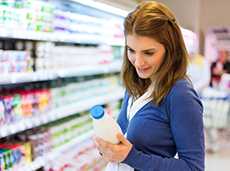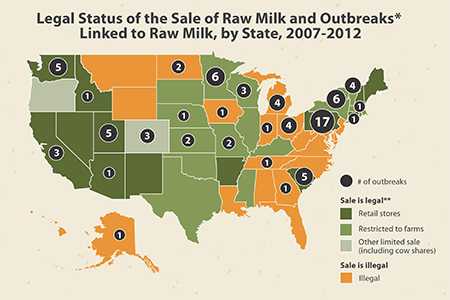Outbreak Studies

CDC has conducted two studies that show an increase in the number of raw milk-associated outbreaks as more states have allowed the legal sale of raw (unpasteurized) milk.
Increased Outbreaks Associated with Nonpasteurized Milk, United States, 2007–2012
This more recent study reviewed outbreaks linked to raw milk in the United States. The study analyzed the number of outbreaks; the legal status of raw milk sales in each state; and the number of illnesses, hospitalizations, and deaths associated with these outbreaks.
What were the findings of this study?
The number of outbreaks linked to raw milk has increased.
- From 2007 through 2012, 26 states reported 81 outbreaks linked to raw milk. The outbreaks caused 979 illnesses and 73 hospitalizations.
- From 2007 through 2009, 30 outbreaks were linked to raw milk. This increased to 51 outbreaks from 2010 through 2012.
- Among outbreaks in which the food or drink linked to the outbreak was identified, the percentage associated with raw milk increased from 2% from 2007 through 2009 to 5% from 2010 through 2012.
- Three germs caused most raw milk outbreaks from 2007 through 2012:
- Campylobacter caused 81% of outbreaks. The number of Campylobacter infections from raw milk nearly doubled in the 6-year period.
- Shiga toxin-producing E. coli caused 17% of outbreaks.
- Salmonella caused 3% of outbreaks.
- The average number of outbreaks linked to raw milk each year was four times higher from 2007 through 2012 than from 1993 through 2006.
Children were at the highest risk for illness from raw milk.
- 59% of outbreaks involved at least one child younger than 5.
- In raw milk outbreaks, children aged 1 to 4 accounted for 38% of illnesses caused by Salmonella and 28% of illnesses caused by Shiga toxin-producing E. coli
More states are legalizing the sale of raw milk even though this leads to an increase in the number of outbreaks.
- 81% of outbreaks were reported in states where the sale of raw milk was legal.
- In 2004, the sale of raw milk was legal in some form in 22 states. This number increased to 30 in 2011.
- The number of states allowing cow-share programs – in which a person buys part ownership of a cow in return for the milk produced – increased from 5 in 2004 to 10 in 2008.
Raw milk sales in one state can lead to outbreaks in neighboring states.
Where do people buy raw milk?
- Dairy farms: farms that keep cows for milk production
- Licensed/commercial sellers: farms or stores separate from a farm
- Cow share or herd share: buyers pay farmers a fee to care for a cow in exchange for a percentage of the milk that is produced
- Buying club: a group of people who purchase food (including dairy products) from farmers at discounted prices
- The raw milk that caused outbreaks came from:
- The dairy farm directly, 71% of the time
- Licensed or commercial milk sellers, 13% of the time
- A cow share or herd share, 12% of the time
- Although raw milk is not included in interstate commerce (across state lines), some states allow sales within their borders.
- In a 2011 outbreak of Campylobacter infections in North Carolina, where sales were prohibited, raw milk was purchased from a “buying club” in South Carolina where sales were legal.
- In a 2012 outbreak of Campylobacter infections in Pennsylvania, where raw milk sales were legal, cases were reported from Maryland, West Virginia, and New Jersey, where sales were prohibited.
More information:
Nonpasteurized (Raw) Dairy Products, Disease Outbreaks, and State Laws—United States, 1993–2006
A previous study reviewed outbreaks linked to dairy products. The study compared outbreaks linked to raw (unpasteurized) dairy products and outbreaks linked to pasteurized dairy products in terms of the types of infection; the numbers of outbreaks, illnesses, hospitalizations, and deaths; and age and sex of the ill people in the outbreaks. This study also compared the number of outbreaks linked to raw dairy products in states that allowed the sale of raw dairy products to the number in states that prohibited the sale of these products.
What were the findings of this study?
Raw milk was much more likely to be linked to outbreaks than pasteurized milk.
- From 1993 through 2006, 121 outbreaks were linked to dairy products identified as pasteurized or unpasteurized (raw). These outbreaks resulted in 4,413 illnesses, 239 hospitalizations, and 3 deaths.
- 73 outbreaks (46 from fluid milk and 27 from cheese) were linked to raw milk, and 48 outbreaks (10 from fluid milk and 38 from cheese) were linked to pasteurized milk.
- Probably no more than 1% of the milk consumed in the United States is raw, yet more outbreaks were linked to raw milk than by pasteurized milk.
- If you consider the number of outbreaks associated with raw milk in light of the very small amount of milk that is consumed raw, the risk of outbreaks linked to raw milk is at least 150 times greater than the risk of outbreaks linked to pasteurized milk.
Outbreaks linked to raw milk tended to cause more severe disease.
- The hospitalization rate for patients in outbreaks linked to raw milk was 13 times higher (13% vs. 1%) than the rate for people in outbreaks linked to pasteurized milk.
- This difference is partly because the outbreaks linked to raw milk were all caused by bacterial infections, which can be severe. For example, E. coli O157:H7, which can cause kidney failure and death, was a common cause of outbreaks linked to raw milk. Relatively mild viral infections and toxins were common causes of outbreaks linked to pasteurized milk.
Younger people were affected more in outbreaks linked raw milk than in outbreaks linked to pasteurized milk.
- From 1993 through 2006, 60% of people sickened in outbreaks linked to raw milk were younger than 20. Only 23% of people in outbreaks linked to pasteurized milk were younger than 20.
- The American Academy of Pediatrics and many other professional organizations advise against feeding raw milk products to children.
States that allow the sale of raw milk had more outbreaks linked to drinking raw milk.
- From 1993 through 2006, 55 outbreaks—or 75%—linked to raw milk occurred in states where it was legal to sell raw milk products.
- The rate of outbreaks linked to raw fluid milk is more than twice as high in states that allow the sale of raw milk than in states than do not allow its sale.
- The rate of outbreaks linked to cheese made from raw milk is nearly six times as high in states that allow the sale of raw milk than in states that do not allow its sale.
- Restricting the sale of raw milk products reduces outbreaks linked to raw milk.
These studies indicate that outbreaks from raw milk continue to threaten the public’s health. You should only consume pasteurized milk and milk products. Look for the word “pasteurized” on product labels.
More Information
- CDC Podcast: Raw or Nonpasteurized Products Can Make You Sick
- CDC Feature: Raw (Unpasteurized) Milk
- FDA Food Facts: The Dangers of Raw Milk
- Page last reviewed: June 8, 2017
- Page last updated: June 8, 2017
- Content source:


 ShareCompartir
ShareCompartir
